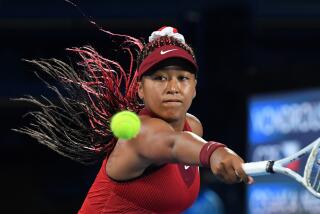TENNIS / THOMAS BONK : There Are More Games Behind the Scenes
- Share via
What’s the worst thing about professional tennis?
By one account, it looks like a first-place tie among greedy agents, pushy parents, shifty promoters and pampered, egocentric athletes who apparently really believe the Earth rotates on their backhands.
Now, does this sound like someone having fun? Monica Seles, 17, wins the U.S. Open and the first words out of her mouth are “What a relief!”
Says John Feinstein: “Whatever happened to joy?”
Feinstein once stuck to writing books about college basketball, which enabled us to learn that the only thing bluer than Bobby Knight’s language (“Season on the Brink”) is the color of the uniforms at Duke (“Forever’s Team”).
Now Feinstein violates the cardinal rule of sportswriting--never cover a sport that doesn’t have a clock--and has branched out to write a book about pro tennis. He paints a picture of a game that is often a lot more profane than Knight ever could be.
In “Hard Courts,” Feinstein writes about spending 1990 on the professional tennis tour, a one-year journey through the maze of agents and deals and politics and money. There is even some tennis being played, although it isn’t nearly as interesting as all the wheeling and dealing occurring in smoke-filled tea rooms.
Despite its faults, tennis is going to make it, Feinstein contends, strictly on its inertia.
“The sport saves itself,” he writes. “Even though the business of the sport is awful, the game itself is great. (But) the public needs to be treated with a little respect. If the public knows a guy is getting $250,000 just for showing up at a tournament, they want to know, ‘Is what we’re seeing real?’ Whether an upset is really an upset starts to be questioned.”
In his chapter on the Davis Cup, Feinstein is highly critical of the United States Tennis Assn., which he claims cut a deal with Andre Agassi to ensure his participation as part of the squad and then denied any arrangement existed.
Feinstein found last week’s Davis Cup news interesting when doubles players Rick Leach and Jim Pugh were replaced despite a 6-0 record in the international competition.
“I don’t think (U.S. Captain) Tom Gorman is calling the shots any more than he was last year,” Feinstein said. “Everybody in tennis knows (former USTA President David) Markin is calling all the shots. Tom would not be here if he had not abandoned his authority to Markin.”
Feinstein said his biggest surprise in doing “Hard Courts” was how much he admired Steffi Graf, who has a reputation for being curt and aloof. Feinstein found Graf to be just the opposite.
“She is not only very bright and interesting, but a warm and sensitive person,” Feinstein said. “The remarkable thing is that she turned out the way she has with the father she has.”
Comparison: Boris Becker is pictured on the cover of the September issue of Gentlemen’s Quarterly. He is wearing a double-breasted wool-rayon-polyester sport coat ($1,460) and a rayon shirt ($495), both by Jean-Paul Gaultier.
In 1972, Jimmy Connors made $200 at the U.S. Open. He played the Open four times before he made a total of $2,000. Maybe he should have worn better clothes.
Star date: To equal Connors’ achievement of reaching the U.S. Open semifinals at 39, Courier will have to do it in 2009.
Last word: A verbatim transcript of an answer by Monica Seles, who probably could talk the ball over the net, when she was asked at her last U.S. Open news conference if she was “mentally dedicated” to improve her serve:
“What I told myself--I always tell this to myself. I told this to myself after the French, Wimbledon. I am going to start serve and volleying, and I probably wouldn’t have serve and volley once at Wimbledon, I think, because of the pressure there. That’s what I told myself.
“I think after the Open, it is time for me to learn things that I needed to add to my game. One is the serve and the second one is volley. To be a complete player, I think that is what I am going to try to do. It’s not easy because I haven’t been volleying for five or six years, even though when I was 7, I was a great volleyer. Then I think--I’ll show you a tape. I think people a lot of times don’t believe it.
“Seeing all those spin volleys, both sides, I think for the serve, to improve, I’ll definitely have to get stronger. I don’t think with the strength, I can serve in the 100s, so, but. . . .”
Palimony suit: Martina Navratilova told reporters covering her palimony lawsuit hearing in Ft. Worth that Judy Nelson was selfish and vindictive after their relationship ended. Navratilova, 34, said she spent $1.6 million in cars, credit cards and cash on her former companion and her family during the seven years they lived together.
Nelson, 45, of Ft. Worth, is suing for as much as half of the $10 million Navratilova earned during their relationship.
“Judy wants me to pay for the pain I caused her in not wanting to be with her anymore,” Navratilova, 34, told the Associated Press.
Navratilova’s defense team has cost her more than $500,000, she said.
Said Navratilova: “If I ever live with somebody else again, man or woman, I’ll make them sign something.”
More to Read
Go beyond the scoreboard
Get the latest on L.A.'s teams in the daily Sports Report newsletter.
You may occasionally receive promotional content from the Los Angeles Times.










